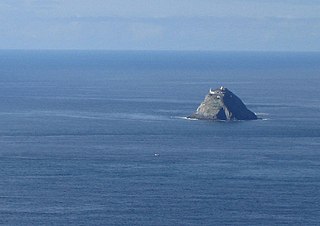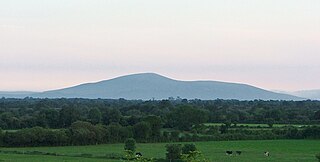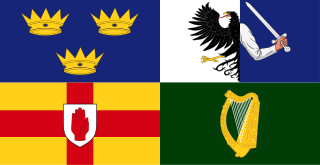Related Research Articles

In Irish mythology, Donn is an ancestor of the Gaels and is believed to have been a god of the dead. Donn is said to dwell in Teach Duinn, where the souls of the dead gather. He may have originally been an aspect of the Dagda. Folklore about Donn survived into the modern era in parts of Ireland, in which he is said to be a phantom horseman riding a white horse.

The mythology of pre-Christian Ireland was preserved in oral tradition. This oral tradition is known as 'Béaloideas'. With the arrival of Christianity, the first manuscripts were written in Ireland, preserving many of these tales in medieval Irish literature. Though the Christian influence is also seen in these manuscripts, this literature represents the most extensive and best preserved of all the branches of Celtic mythology. Although many of the manuscripts have not survived and much more material was probably never committed to writing, there is enough remaining to enable the identification of distinct, if overlapping, cycles: the Mythological Cycle, the Ulster Cycle, the Fenian Cycle and the Historical Cycle. There are also a number of extant mythological texts that do not fit into any of the cycles, and many recorded folk tales that continued as the oral tradition ran parallel to the manuscript tradition which, while not strictly mythological, feature personages from one or more of these four cycles.

Fionn mac Cumhaill was a mythical hunter-warrior in Irish mythology, occurring also in the mythologies of Scotland and the Isle of Man. The stories of Fionn and his followers, the Fianna, form the Fenian Cycle, much of it narrated in the voice of Fionn's son, the poet Oisín.

Manannán or Manann, also known as Manannán mac Lir, is a warrior and king of the Otherworld in Irish mythology who is associated with the sea and often interpreted as a sea god, usually as a member of the Tuatha Dé Danann.

Nechtan is a figure in Irish mythology who is associated with a spring marking the source of the River Boyne, known as Nechtan's Well or the Well of Wisdom. He was the husband of Boann, eponymous goddess of the Boyne. Nechtan is believed to be another name for Nuada.

In Irish mythology, Nuada or Nuadu, known by the epithet Airgetlám, was the first king of the Tuatha Dé Danann. He is also called Nechtan, Nuadu Necht and Elcmar, and is the husband of Boann. He is mostly known from the tale in which he loses his arm or hand in battle, and thus his kingship, but regains it after being magically healed by Dian Cécht. Nuada is thought to have been a god and is related to the British and Gaulish god Nodens, who is associated with hunting and fishing. His Welsh equivalent is Nudd or Lludd Llaw Eraint.
In Irish mythology, Balor or Balar was a leader of the Fomorians, a group of malevolent supernatural beings. He is often described as a giant with a large eye that wreaks destruction when opened. Balor takes part in the Battle of Mag Tuired, and is primarily known from the tale in which he is killed by his grandson Lugh of the Tuatha Dé Danann. He has been interpreted as a personification of the scorching sun, and has also been likened to figures from other mythologies, such as the Welsh Ysbaddaden and Greek Cyclops.
Cessair or Cesair is a character from the Lebor Gabála Érenn, a medieval Christian pseudohistory of Ireland. According to the Lebor Gabála, Cessair was the leader of the first inhabitants of Ireland, arriving before the biblical flood. The tale may have been an attempt to Christianize an earlier pagan myth, but may also have been the product of post-conversion pseudohistory.

Niamh or Niam, in the Irish Fenian Cycle, is the lover or spouse of Oisín, son of Fionn mac Cumhail.

The Fenian Cycle or Fiannaíocht or the Finn Cycle, also referred to as the Ossianic Cycle after its narrator Oisín, is a body of prose and verse centring on the exploits of the mythical hero Fionn mac Cumhaill and his warriors the Fianna.
Gráinne is the daughter of Cormac mac Airt in the Fenian Cycle of Irish mythology. She is one of the central figures in the Middle Irish text Finn and Gráinne and, most famously, in the 17th-century tale The Pursuit of Diarmuid and Gráinne, which tells of her betrothal to Fionn mac Cumhaill, leader of the Fianna, and her subsequent elopement with Fionn's warrior Diarmuid Ua Duibhne.
Nuadu Necht, son of Sétna Sithbac, a descendant of Crimthann Coscrach, of the Laigin, was, according to medieval Irish legend and historical tradition, a High King of Ireland. He came to power after killing his predecessor, Eterscél, and ruled for six months, at the end of which he was killed by Eterscél's son Conaire Mór.

Slievenamon or Slievenaman is a mountain with a height of 721 metres (2,365 ft) in County Tipperary, Ireland. It rises from a plain that includes the towns of Fethard, Clonmel and Carrick-on-Suir. The mountain is steeped in folklore and is associated with Fionn mac Cumhaill. On its summit are the remains of ancient burial cairns, which were seen as portals to the Otherworld. Much of its lower slopes are wooded, and formerly most of the mountain was covered in woodland. A low hill attached to Slievenamon, Carrigmaclear, was the site of a battle during the Irish Rebellion of 1798.

The Oilliphéist is a sea serpent-like monster in Irish mythology and folklore.

The Salmon of Knowledge is a creature figuring in the Fenian Cycle of Irish mythology, sometimes identified with Fintan mac Bóchra, who was known as "The Wise" and was once transformed into a salmon.
The Boyhood Deeds of Fionn is a medieval Irish narrative belonging to the Fenian Cycle of Irish mythology. As its title implies, it recounts the boyhood exploits of Fionn mac Cumhaill, the cycle's central figure.
Gilla in Chomded húa Cormaic was a Gaelic-Irish poet of the early Middle Ages, fl. c. 1150 - c.1170.

The High Deeds of Finn Mac Cool is a children's novel by Rosemary Sutcliff and was first published in 1967. It is a retelling of the stories of Fionn mac Cumhaill and the Fenian Cycle. According to her own statements in the introduction, these stories are closer to Folklore and Fairytale, being timeless and contradictory, having organically grown from generations of storytellers; she contrasts them to the Ulster Cycle stories of Cuchulainn, which belong to the Heroic Epic, and compare with the Iliad and the Odyssey.
Emain Ablach is a mythical island paradise in Irish mythology. It is often regarded as the realm of the sea god Manannán Mac Lir and identified with either the Isle of Man or the Isle of Arran. According to the medieval Irish poem Baile Suthain Sith Eamhna, the god Lug Lamfada was reared in Emain Ablach. In another poem from the 14th century, Emain Ablach is described as being filled with swans and yews.
Dáithí Ó hÓgáin, Irish folklorist, was professor of Irish folklore at University College Dublin. Born in Co. Limerick, he was a writer well-versed both in English and Irish, as well as being an academic.
References
- ↑ Koch, John T (2006). Celtic Culture a historical encyclopaedia. p. 749. ISBN 1-85109-440-7.
- ↑ James Larson, Gerald (1974). Myth in Indo-European Antiquity. p. 71. ISBN 0-520-02378-1.
- ↑ Ériu volume 44 to 46. p. 152.
- ↑ Campbell, J.J (1955). Legends of Ireland. Batsford. p. 160.
- ↑ Ó hÓgáin, Dáithí, Myth, Legend and Romance, entry under Find.